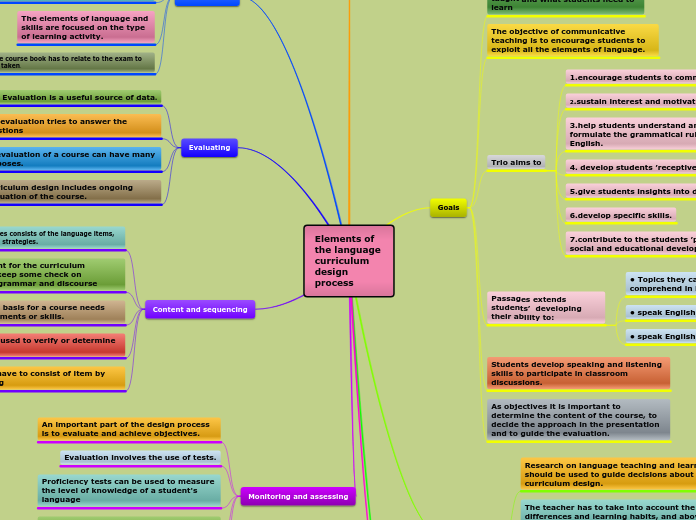Negotiated syllabus
Interaction with others that one uses and acquires language
Lexical Syllabus
Spoken and written language
Notional-function syllabus
Wich people use the language
Grammatical, formal, or structural syllabuses
Grammatica structures of the language
The process of measuring and judging the extent to which the planned courses, programmes, learning activities and opportunities as expressed in the formal curriculum actually produce the expected results
Refers to the actual curricular content that students engage in the classroom
Is a complex process where faculty define intended learning outcomes, assessments, content and pedagogic requirements necessary for student success across an entire curriculum
Is the combination of instructional practices, learning experiences and students performance assessment that are designed to bring out and evaluate the target learning of a particular course
The three main curricular process are
Evaluating
Enacting
Planning
A course of a study that will enable the learner to acquire specific knowledge and skills.
Syllabus is our guide to a course and what will be expected of you in the course
Your syllabus is provides students with a comprehensive overview of the course´s aims and objectives learning outcomes and assessment strategies
basic elements of a course including:
Assignments
List of tests
Weekly schedule
Topics
Syllabus and Curriculum Design for a Second Language Teaching
Syllabus content
Consists of what students are expect to learn and learn how to do in the course. The purpose of determining the content is to ensure that what the course focuses on is appropriate for the students.
Syllabus content categories
Sociopolitical skills
Cultural/pragmatic knowledge and skills
Vocabulary
Grammar
Metacognitive skills and learning strategies
Projects
Task
Text types (genres)
Specific content areas
Topics, themes
Macro skills
Determining syllabus content
As we discussed in the section on syllabus types, the nature of language and language learning makes defining goals and deciding on the content that will enable learners to achieve the goals challenging.
What is a syllabus?
Syllabus types
What is a curriculum?
How to design a syllabus?
Needs assessment
The purpose of needs assessment is to have as much information as possible about the learners, their needs, and their purposes to set realistic learning targets.
Types of information
Purposes for study
Interests and life experience
Educational background information
Length, place, and focus of education; expectations of teacher/learner roles
Demographic information
Age, gender, nationality, first and other languages
Context analysis
The process of context analysis involves identifying the resources and contraints that will have an impact on the course and making decisions about how to account for factors that are particularly challenging.
Factors to consider in a context analysis
Social, cultural, and political factors
Educational Requirements
Human Resources
Physical resources
Time
Processes of designing a syllabus
Designing a syllabus forces us to think about both the whole and all the parts of a course-how the trees make up the forest.
Deciding on goals and objectives
Objectives
Objectives are specific statement of what learners will know and be able to do. They are obtainable and measurable to the extent that learners should have some way go knowing whether the objective has been reached.
Goals
We plan the goals of the course based on what we know about learners' needs and the context, and based on our own understandings of language, learning, and language learning.









